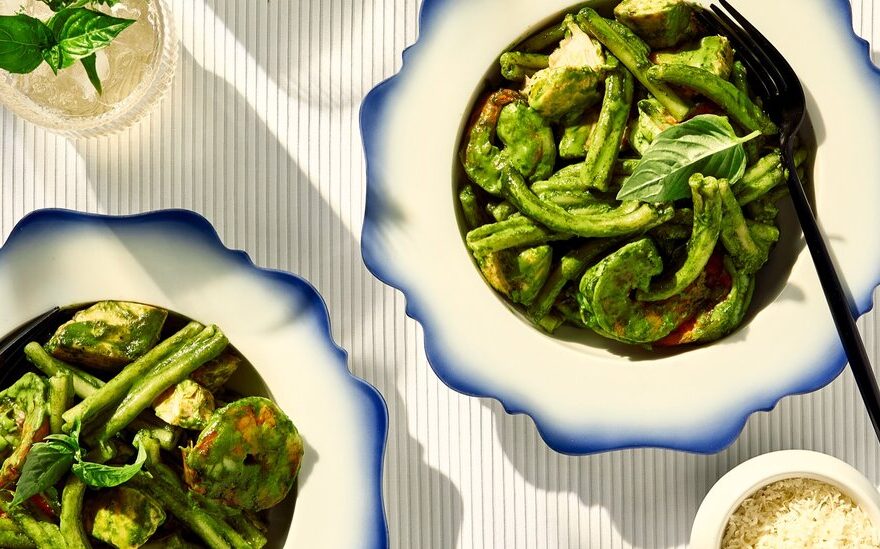My colleague Julia Moskin says that restaurants are New Yorkers’ living rooms. With no space of our own, we look outward, to nearby public quarters where we can sit, read and lounge. If that’s true — and I think it is — for more than a decade, I’ve watched my favorite living room, Da Andrea, an Italian restaurant in New York City, grow more and more successful, filling with guests I’ve never seen before. At first I was irked, but over time I’ve learned that sharing a living room is much better than losing it forever.
When I first fell in love with Da Andrea, as a student whose internship checks went directly to meals out, the Northern Italian restaurant on West 13th Street was a quiet space, where mostly local residents met their children (or grandchildren) for dinner. And it was where I liked to eavesdrop on first dates or read, more often than not finishing an assignment for class.
Recipe: Pesto Pasta With Shrimp and Salmon
Through the many changes in ownership, layout, personnel, location and clientele, one dish remained on the menu: a ricotta cavatelli with the most viridescent pesto. Until very recently, the Nickelodeon-green, almost teal pesto was a total mystery to me, a recipe I tried to replicate for years to no avail. But it’s the key to this dish, the most striking feature of an otherwise ordinary seafood pasta. Anyone who makes pesto knows how quickly that vibrant color can turn brown and pasty. But the pesto at Da Andrea is always shiny velvet, a shade of green that feels as if you’ve blended neon Chicago-dog relish into cream.
A few weeks ago, at 9 on a Monday morning, I went to Da Andrea to see how the executive chef, Meliano Plasencia, 63, makes the dish. He was busy: A grocery shipment had come in late. But he threw me some spare chef’s whites anyway and walked me through the recipe he has been making for decades. In just half an hour, by watching Plasencia cook in an unfamiliar kitchen (though it had fed me for 13 years), I learned everything I needed to know about that pesto.
Like the restaurant, the pesto has evolved and adapted to its time — and therein lies its staying power. The pine nuts in his original recipe, which won second place in a pesto invitational back in 1985, have been nixed in recent years to accommodate diners with allergies. People often think that cooking is additive — that the more ingredients there are, the better the taste — but what I’ve learned over the years is that removing an ingredient or two can help the whole thing shine that much brighter. Without the nuts, the pesto was pure basil, its floral aroma buoyed by an unbreakable emulsion of liquid and fat.
A hue so deep, it feels as if you’ve blended neon Chicago-dog relish into cream.
When Plasencia added ice to the blender — to keep the mixture cool from the heat of the blender so the basil wouldn’t oxidize — I gasped. If good chefs know how to use heat, then great ones know how to control it. (As he cooked the seafood, he said to me three different times, “I try not to overcook too much.”) The softest morsels of pink salmon and shrimp, gently tossed in a hot pan with olive oil and a splash of vegetable stock, are just heated through, which is how delicate fish should always be treated. If the pesto is the galaxy of this pasta, then the perfectly cooked seafood pieces are its brightest stars.
In an age when favorite restaurants are gate-kept, I’ve found that letting people know about a local spot means helping those businesses grow and, more important, stay afloat. I’ve had several favorites close down in the past decade — Caffe Falai, Hiroko’s Place, Tahini — and I’ve regretted not going to them more, not shouting about them from the rooftops.
When I eat at Da Andrea, the food tastes just as good as when I first tried it as a 19-year-old English major, staining my paperbacks with pesto and olive oil. My old seat, once tucked into a corner, is now a bar where I sometimes like to go for a drink before my table is ready. Sometimes, the maître d’, whom I’ve known since I was a teenager, motions me to the back, unfolds a table for one and sets it for me with a basket of house-made focaccia and a carafe of red wine. It’s by the bathroom, but to this day it’s my favorite seat in the house.
Recipe: Pesto Pasta With Shrimp and Salmon
Eric Kim is a cooking writer for the Food section and NYT Cooking and a columnist for The New York Times Magazine. More about Eric Kim
Source: Read Full Article
